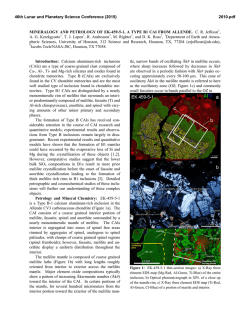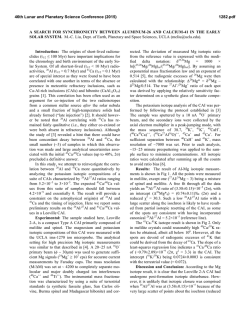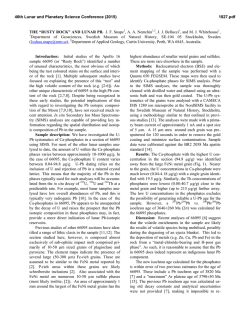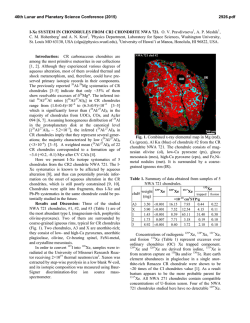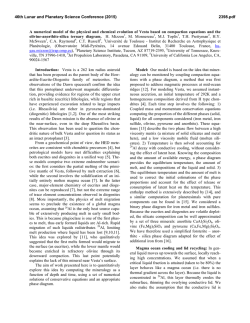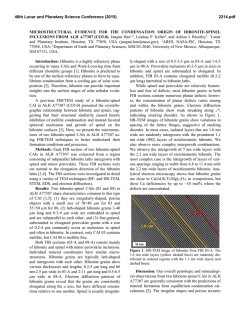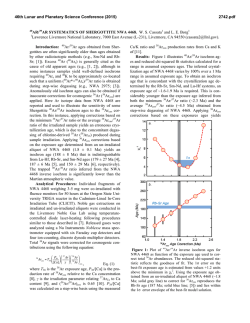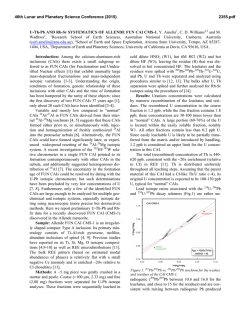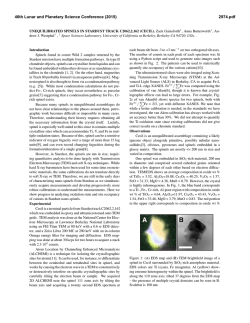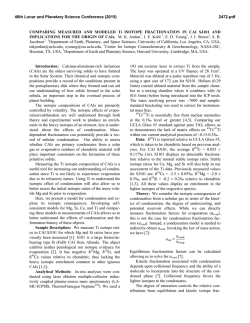
High Precision Al-Mg Systematics of Forsterite
46th Lunar and Planetary Science Conference (2015) 1971.pdf HIGH PRECISION AL-MG SYSTEMATICS OF FORSTERITE-BEARING TYPE B CAIS. E. S. Bullock1, T. J. Tenner2, D. Nakashima2, 3, N. T. Kita2, G. J. MacPherson1, M. A. Ivanova1,4, A. N. Krot5, M. I. Petaev6, S. B. Jacobsen6. 1Smithsonian Institution, Washington, DC, USA. 2WiscSIMS, University of Wisconsin, Madison, WI 53706, USA. 3Tohoku University, Miyagi 980-8578, Japan. 4Vernadsky Institute, Moscow, Russia. 5University of Hawai‘i , Honolulu, Hawai‘i 96822, USA. 6Harvard University, Cambridge, Massachusetts 02138, USA. Email: [email protected]. Introduction: Forsterite-bearing Type B inclusions (FoBs) are a rare group of Ca-Al-rich inclusions (CAIs) with petrologic (and isotopic) properties indicating significant degrees of melt evaporation ([1] and references therein). We have previously shown that FoBs define an evolutionary sequence from sintered aggregates of fine-grained pyroxene + spinel + melilite + forsterite, through to highly melted and partially melt-evaporated objects [1]. FoBs develop a “mantle” of forsterite-free melilite + pyroxene as a result of melt evaporation: the thicker the mantle, the more evaporation the inclusion has undergone. Melilite and pyroxene also trend towards more Al-rich compositions, as Mg and Si are lost through volatilization. The timing of melt evaporation, and the age relationship between FoBs and other CAIs, are the subjects of this work. We previously reported [2] data for high-Mg, lowAl minerals in these inclusions. Those results indicate that FoBs were remelted over a time period of ~200,000 years, consistent with other igneous CAIs from CV3 chondrites [3]. Here we report highprecision Al-Mg isotope internal isochron data for gehlenitic melilite and anorthite in a suite of diverse FoBs in order to refine the mineral isochrons, and thus better determine the initial (26Al/27Al) ratio [(26Al/27Al)0] for each inclusion. Method: Grains of gehlenitic melilite and anorthite were identified using the FEI Nova NanoSEM at the Smithsonian Institution. Al-Mg isotopic analyses were performed using the WiscSIMS Cameca ims 1280 ion probe (see [4] for experimental details). Data were reduced using β = 0.514 [5]. Seven FoBs were analyzed: ALVIN, SJ101, and TS35 from Allende; E60 and E64 from Efremovka, 3137-2 from Vigarano and 4N from NWA 3118. After SIMS analysis, each ion probe pit was imaged using an SEM to make sure it did not overlap any other mineral phases or cracks. Results and Discussion: The Al-Mg isotope systematics for each individual FoB are described below, and are presented in order from the most primitive through to the most evaporated object. In each case, data from spinel grains that were located in anorthite or nepheline were rejected, as they show evidence of exchange and plot above the mineral isochron [3]. SJ101: This large FoB has a sinuous internal texture, and is interpreted to be the most primitive FoB. It has (26Al/27Al)0 = (5.24±0.53) × 10-5 (Fig. 1), close to the canonical value of (5.23±0.13) ×10-5 [6] and con- sistent with it being an early-forming inclusion. This isochron is constrained by spinel (27Al/24Mg ~2.5), since there is no Al-rich melilite or pyroxene within the inclusion. Anorthite grains show some excess 26Mg*, but plot below the isochron defined by the other minerals. ALVIN: This FoB has a thin forsterite-free mantle, and is interpreted to have undergone limited degrees of melt evaporation [1]. It has (26Al/27Al)0 = (4.22±0.43) × 10-5, consistent with crystallization ~220,000 years after CAIs with the canonical (26Al/27Al)0 [6]. The single anorthite analysis shows no excess 26Mg*. E64: This small inclusion with a thin forsterite-free mantle has (26Al/27Al)0 = (5.14±0.35) × 10-5, very close to the canonical value of [6]. The mineral isochron is based on forsterite, pyroxene, spinel and melilite. The melilite data show a degree of scatter, but not as a result of inclusions/cracks - all of the included analyses are of clean spots. Anorthite within this inclusion shows no excess 26Mg*. E60: This heart-shaped FoB was previously studied by [7], for Pb-Pb and Al-Mg chronology, in which they showed an internal isochron including plagioclase with (26Al/27Al)0 = (4.63±0.44) × 10-5. Subsequent LA-ICPMS analyses [8] of the Al-Mg isotopic systematics of this inclusion indicated that it has undergone isotopic disturbance. Our high-precision SIMS analysis of åkermanitic melilite within this inclusion shows a smaller degree of scatter than [8], though several analyses plot above an isochron based on olivine, spinel and gehlenitic melilite. Removing the melilite that plot above the isochron results in an (26Al/27Al)0 of (5.27±0.22) × 10-5, close to the canonical value [6], indicating it crystallized early. Anorthite in E60 does show some excess 26Mg*, but data plot well below an isochron defined by the other minerals. 3137-2: This FoB CAI has a thick forsterite-free mantle, indicating a high degree of melt evaporation. The mineral isochron gives (26Al/27Al)0 = (4.81±0.35) × 10-5, indicating crystallization ~80,000 years after canonical CAIs. The only gehlenitic melilite in this inclusion occurs close to the meteorite fusion crust, and thus is potentially disturbed, so it was not analyzed. As in E60, åkermanitic melilite shows some scatter above the mineral isochron, while anorthite shows no excess 26 Mg*. TS35: This FoB shows clear evidence of melt evaporation, and has (26Al/27Al)0 = (4.74±0.28) × 10-5 46th Lunar and Planetary Science Conference (2015) (Fig. 2). Anorthite shows no excess 26Mg*, but gehlenitic melilite plots on the same isochron defined by the Mg-rich minerals. 4N: This FoB was not included in the original study of [1]; however its texture and mineral chemistry indicate that it has undergone moderate melt evaporation. It has (26Al/27Al)0 = (4.75±0.32) × 10-5, suggesting recrystallization ~100,000 years after canonical CAIs. Anorthite within this inclusion shows excess 26Mg*, but does not plot on the mineral isochron. The range in (26Al/27Al)0 ratios recorded by FoBs indicates their melting and solidification over a ~200,000 year time period, which is consistent with other remelted CAIs from CV3 chondrites (e.g. [3]). The initial 26Al/27Al ratio for a given inclusion does not correlate with the degree of melting based upon mineralogical and textural criteria. One of the least-melted FoBs, ALVIN, appears to have been remelted late (~200,000 years after canonical), while a more extensively evaporated inclusion, E60, was remelted very early. This suggests multiple episodes of melting and 1971.pdf processing of FoBs in the solar nebula, consistent with their petrographic characteristics [1,9]. Anorthite in all of the studied inclusions is moderately to completely disturbed and plots below the isochrons defined by the other phases (Figs. 1 & 2). Thus it cannot be used to constrain the mineral isochron at high Al/Mg ratios. Melilite in E60 and 3137-2 also shows some scatter above the mineral isochron, possibly as a result of exchange with spinel. The susceptibility of melilite to isotopic exchange requires further study. References: [1] Bullock E. S. et al. (2012) MAPS, 47, 2128‒2147. [2] Bullock E. S. et al. (2014) Goldschmidt Abs. #3406. [3] MacPherson G. J. et al (2012) EPSL 331, 43‒54. [4] Kita N. T. et al. (2012) GCA 86, 37-51. [5] Davis A. M. et al. (2005) LPSC 36 #2334. [6] Jacobsen B. et al. (2008) EPSL 272, 353‒364. [7] Amelin Y. et al. (2002) Science 297, 1678‒1683. [8] Wadhwa, M. et al. (2009) LPSC 40 #2495. [9] Petaev M. I. and Jacobsen S. B. (2009) GCA, 73, 5100‒5114. Figure 1. Al-Mg isochron of FoB Allende CAI SJ101, the most primitive FoB in this study. It has (26Al/27Al)0 = (5.24±0.53) × 10-5, based on data from olivine, spinel, melilite and pyroxene. Anorthite shows some excess 26Mg*, but plots below the isochron defined by other minerals (see inset). Figure 2. Al-Mg isochron of FoB Allende CAI TS35, which underwent the greatest degree of melt volatilization of all inclusions in this study. It has (26Al/27Al)0 = (4.74±0.28) × 10-5, based on data from olivine, spinel, melilite and pyroxene. Anorthite is completely disturbed and thus was not included in the isochron calculation (see inset).
© Copyright 2026
